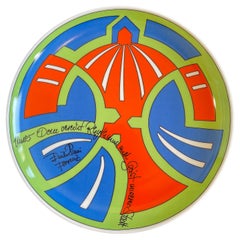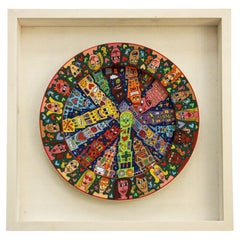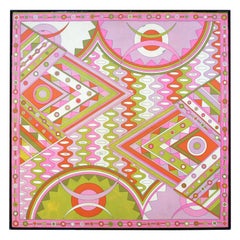Emilio Pucci Wall Decorations
By the mid-1960s, the international fashion press, enamored of his dazzling scarves and slithery dresses in sensuous psychedelic silk jersey, had dubbed Florentine designer Emilio Pucci the Prince of Prints. Less well known is that, starting in the early 1950s, Pucci applied his colorful, abstract patterns to static angular mediums such as ceramics, floors and furniture, imbuing them with movement, not to mention glamour. He was the first fashion designer to enter the lifestyle market, founding the successful brand that exists today.
Born in 1914 to one of Italy’s oldest noble families, Emilio Pucci, Marchese Pucci di Barsento, was a member of the postwar international jet set, hopping from beach to mountain to city. His fashion career began unexpectedly in 1947, when he created a revolutionary stretch ski outfit that was photographed on the Swiss slopes for Harper’s Bazaar.
Eschewing a life of aristocratic glamour, the self-taught Pucci opened a boutique on Capri dedicated to simple resort clothing (think capri pants) that evoked the Mediterranean’s undulating waves and refreshingly bright colors. At the time, luxury fashion was as constricted as a Dior cocktail dress, but the Swinging Sixties were on the horizon. Signed with what Vogue International editor Suzy Menkes calls a “handwritten ‘Emilio’ flourish” — a concept, she points out, as novel as that of designer ready-to-wear — his designs were soon seen on celebrities like Jackie Kennedy and Marilyn Monroe.
From the airline uniforms he created for Braniff in the 1960s to the emblem he crafted for the Apollo XV space mission in 1971, Pucci’s designs were visionary. In spite of his traditional roots (or because of them), the Prince of Prints was forward thinking and outward looking. Pucci put his signature flourish on patterns that were flexible — first for fashion, then for furnishings and objects. Whether on fabric or foam, shelves or sails, as he first explained some 70 years ago, the ornamental designs work in “continuous motion.” Venturing into nontraditional design partnerships, he laid the groundwork for a future brand, a classic legacy that his daughter Laudomia Pucci continues today.
Find vintage Emilio Pucci evening dresses, scarves, skirts and other clothing and accessories on 1stDibs.
Mid-20th Century German Mid-Century Modern Emilio Pucci Wall Decorations
Porcelain
Late 20th Century German Post-Modern Emilio Pucci Wall Decorations
Porcelain
Late 20th Century American Expressionist Emilio Pucci Wall Decorations
Porcelain
1890s German Rustic Antique Emilio Pucci Wall Decorations
Ceramic, Faience
Mid-20th Century German Expressionist Emilio Pucci Wall Decorations
Porcelain
1970s German Mid-Century Modern Vintage Emilio Pucci Wall Decorations
Porcelain
1980s German Modern Vintage Emilio Pucci Wall Decorations
Porcelain
1970s European Vintage Emilio Pucci Wall Decorations
Porcelain
1980s Italian Mid-Century Modern Vintage Emilio Pucci Wall Decorations
Porcelain
1970s German Vintage Emilio Pucci Wall Decorations
Porcelain
1960s German Vintage Emilio Pucci Wall Decorations
Porcelain, Textile
1980s Italian Mid-Century Modern Vintage Emilio Pucci Wall Decorations
Ceramic
1960s Mid-Century Modern Vintage Emilio Pucci Wall Decorations
Copper
1970s Italian Mid-Century Modern Vintage Emilio Pucci Wall Decorations
Silk
1960s Italian Mid-Century Modern Vintage Emilio Pucci Wall Decorations
Fabric
1970s Italian Modern Vintage Emilio Pucci Wall Decorations
Wood, Paper
1970s Italian Modern Vintage Emilio Pucci Wall Decorations
Metal
Emilio Pucci wall decorations for sale on 1stDibs.
Creators Similar to Emilio Pucci
- Is Guess part of Emilio Pucci?1 Answer1stDibs ExpertApril 5, 2022No, Guess is not a part of Emilio Pucci. Since 2000, Emilio Pucci has been owned by the holding company LVMH Moët Hennessy Louis Vuitton. Pucci was added to this group under the leadership of current CEO and chairman Bernard Arnault. On 1stDibs, shop a collection of Emilio Pucci fashions from some of the world’s top boutiques.
- 1stDibs ExpertApril 5, 2022There are dozens of ways to tie and wear an Emilio Pucci scarf, and the best way is really a matter of preference. Whether you like to have it draped over your shoulders or tied like a shawl, experiment to find the style that suits each of your looks best. Shop a collection of Emilio Pucci scarves from some of the world’s top boutiques on 1stDibs.
- How do I pronounce Emilio Pucci?1 Answer1stDibs ExpertApril 5, 2022Emilio Pucci is and Italian name, pronounced “uh-MEE-lee-ow POO-chee.” The company is named after Emilio Pucci who founded it in 1947. Today, modern collections from his company and vintage examples of his work are sought after by collectors. On 1stDibs, shop a wide array of vintage and contemporary Emilio Pucci clothing and accessories.
- Who owns Emilio Pucci?1 Answer1stDibs ExpertApril 5, 2022The luxury company Emilio Pucci is owned by the holding company LVMH Moët Hennessy Louis Vuitton, often known simply as LVMH. Pucci was added to the group in 2000, under the leadership of current CEO and chairman Bernard Arnault. On 1stDibs, find a collection of vintage and contemporary Emilio Pucci clothing and accessories from some of the world’s top sellers.
- 1stDibs ExpertApril 5, 2022Camille Miceli has been the artistic director of Emilio Pucci since September 2021. Miceli came to the brand with experience from Chanel, Louis Vuitton, and Christian Dior. Find a collection of expertly-vetted Emilio Pucci clothing and accessories from some of the world’s top boutiques on 1stDibs.
- Who is Emilio Pucci?1 Answer1stDibs ExpertApril 5, 2022Emilio Pucci was an Italian fashion designer who founded his own fashion house in 1947. In the mid-20th century, Pucci’s joyful and dynamic designs were seen as a transition between luxurious couture and a new era of ready-to-wear pieces. Today, modern collections from his company and vintage examples of his work are celebrated by collectors. On 1stDibs, shop a wide array of vintage and contemporary Emilio Pucci clothing and accessories.
- 1stDibs ExpertApril 5, 2022A keen sportsman, Emilio Pucci first designed clothes for the ski team at Reed College in Portland, Oregon. Soon after, he set up his own house of haute couture on the Isle of Capri to produce athletic wear for American manufacturers. On 1stDibs, you’ll find a collection of vintage and contemporary Emilio Pucci clothing and accessories from some of the world’s top boutiques.
- 1stDibs ExpertApril 5, 2022Emilio Pucci’s famous ski clothes used a signature fabric, dubbed “Emilioform,” which was developed in 1960. A special blend of shantung silk and nylon, it was designed to be aerodynamic and took the world by storm. Shop a wide collection of expertly-vetted Emilio Pucci clothing and accessories from some of the world’s top sellers on 1stDibs.
- 1stDibs ExpertApril 5, 2022Can’t find anything definitive for this one…
- 1stDibs ExpertApril 5, 2022No, Ralph Pucci is not related to famed fashion designer Emilio Pucci. Ralph Pucci is an American entrepreneur known for his mannequin design and luxury furniture through Ralph Pucci International. Shop a collection of Ralph Pucci furniture from some of the world’s top sellers on 1stDibs.
- 1stDibs ExpertMarch 22, 2022Yes, Emilio Pucci is a designer brand of clothing and homewares founded by a designer by the same name in 1947. Today, the brand is well known for its bold, colorful prints. On 1stDibs, find a range of Emilio Pucci apparel, accessories and handbags.
- 1stDibs ExpertFebruary 7, 2024Emilio Pucci used a variety of materials for his clothing and accessories. The Italian fashion designer favored natural materials like cotton and cashmere and gained notoriety for his signature jersey silk fabric. Pucci's colorful prints became synonymous with his eponymous fashion house and went on to influence the next generation of designers. On 1stDibs, shop a variety of Pucci apparel and accessories.




